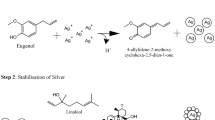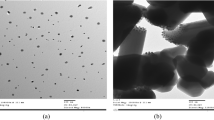Abstract
A simple but cost-effective method for preparing a novel partially carboxymethylated cotton gauze (PCG) with silver nanoparticles (AgNPs; i.e., PCG/Ag) was developed through carboxymethylation modification and reduction of Ag nitrate using polyvinylpyrrolidone (PVP) as a coating and complexing agent. The Fourier transform infrared spectrum of PCG/Ag revealed an absorption band at 1610 cm−1 and no chemical conversion in the synthesis of AgNPs. The synthesis of spherical AgNPs with a diameter of 5–20 nm was confirmed by ultraviolet–visible spectroscopy and showed plasmon resonance peaks at 425 nm; X-ray diffraction analysis revealed peaks at 2θ = 38.3° and 44.2° and X-ray photoelectron spectroscopy showed two peaks at 374.2–376.9 and 368.2–371.0 eV. AgNPs attached to partly carboxymethylated cotton gauze were optimized by a one-factor-at-a-time approach; the optimized conditions for an antimicrobial effect with no cytotoxicity was 30 min of soaking in 0.4% (w/v) Ag nitrate and reduction in 0.5% (w/v) ascorbic acid in the presence of defined amounts of PVP with stirring. PCG/Ag-4 showed excellent water absorption exceeding 2000% of the initial value. The inhibition zone test and bacterial growth inhibition curves suggested that PCG/Ag had antimicrobial activity against Escherichia coli and Staphylococcus aureus. The cell viability and cell attachment assays confirmed that the PCG/Ag was not cytotoxic and promoted wound healing in an animal model. These results indicate that PCG/Ag is a safe and effective material for wound dressing. This novel in-situ reduction method for obtaining uniformly dispersed nanoparticles on a biomaterial for wound dressing can be applied on a large scale without sacrificing low cost and efficiency.
Graphical abstract








Similar content being viewed by others

References
Aymonier C, Schlotterbeck U, Antonietti L, Zacharias P, Thomann R, Tiller JC, Mecking S (2002) Hybrids of silver nanoparticles with amphiphilic hyperbranched macromolecules exhibiting antimicrobial properties. Chem Commun 8:3018–3019
Barkhordari S, Yadollahi M, Namazi H (2014) pH sensitive nanocomposite hydrogel beads based on carboxymethyl cellulose/layered double hydroxide as drug delivery systems. J Polym Res 21:454
Bera S, Gangopadhyay P, Nair KGM, Panigrahi BK, Narasimhan SV (2006) Electron spectroscopic analysis of silver nanoparticles in a soda-glass matrix. J Electron Spectrosc Relat Phenom 152:91–95
Chen J, Lan G, Li K, Liu S, Yu K, Liu J, Tang H, Dai F, Wu D (2016) Preparation of a partially carboxymethylated cotton gauze and study of its hemostatic properties. J Mech Behav Biomed Mater 62:407–416
Donnadio A, Ambrogi V, Pietrella D, Pica M, Sorrentino G, Casciola M (2016) Carboxymethylcellulose films containing chlorhexidine–zirconium phosphate nanoparticles: antibiofilm activity and cytotoxicity. RSC Adv 6:46249–46257
Ellis LJA, Valsami-Jones E, Lead JR, Baalousha M (2016) Impact of surface coating and environmental conditions on the fate and transport of silver nanoparticles in the aquatic environment. Sci Total Environ 568:95–106
Elsner JJ, Berdicevsky I, Zilberman M (2010) In vitro microbial inhibition and cellular response to novel biodegradable composite wound dressings with controlled release of antibiotics. Acta Biomater 7:325–336
Escobedo-Lozano AY, Domard A, Velázquez CA, Goycoolea FM, Argüelles-Monal WM (2015) Physical properties and antibacterial activity of chitosan/acemannan mixed systems. Carbohydr Polym 115:707–714
Eyler RW, Klug ED, Diephuis F (1947) Determination of degree of substitution of sodium carboxymethylcellulose. Anal Chem 19:24–27
Gang C, Jingdong Z, Munetaka O, Kazuyuki H (2006) Silver-nanoparticle-attached indium tin oxide surfaces fabricated by a seed-mediated growth approach. J Phys Chem Part B Condens Matter Mater Surf Interfaces Biophys 109:1204–1209
Guo S, DiPietro LA (2010) Critical review in oral biology & medicine: factors affecting wound healing. J Dent Res 89:219–229
Guo A, Wang F, Lin W, Xu X, Tang T, Shen Y, Guo S (2014) Evaluation of antibacterial activity of N-phosphonium chitosan as a novel polymeric antibacterial agent. Int J Biol Macromol 67:163–171
José VS (2010) Chronic wounds treated with iodinated cadexomer. Study of a series of clinical cases with Iodosorb. Revista de enfermeria? (Barcelona, Spain) 33:38–42
Kučišec-Tepeš N (2016) The role of antiseptics and strategy of biofilm removal in chronic wound. Acta Med Croat 70:33–41
Kumar V, Gundampati RK, Singh DK, Bano D, Jagannadham MV, Hasan SH (2016) Photoinduced green synthesis of silver nanoparticles with highly effective antibacterial and hydrogen peroxide sensing properties. J Photochem Photobiol B 162:374
Kutsenko LI, Bochek AM, Vlasova EN, Volchek BZ (2005) Synthesis of carboxymethyl cellulose based on short fibers and lignified part of flax pedicels (boon). Russ J Appl Chem 78:2014–2018
Li X, Liu Y, Zhang J, You R, Qu J, Li M (2017) Functionalized silk fibroin dressing with topical bioactive insulin release for accelerated chronic wound healing. Mater Sci Eng C 72:394–404
Marin S, Vlasceanu GM, Tiplea RE, Bucur IR, Lemnaru M, Marin MM, Grumezescu AM (2015) Applications and toxicity of silver nanoparticles: a recent review. Curr Top Med Chem 15:1596–1604
Nam JM, Park SJ, Mirkin CA (2002) Bio-barcodes based on oligonucleotide-modified nanoparticles. J Am Chem Soc 124:3820
Nayak S, Kundu SC (2014) Sericin–carboxymethyl cellulose porous matrices as cellular wound dressing material. J Biomed Mater Res Part A 102(6):1928–1940
Petersen W, Rahmanian-Schwarz A, Werner J-O, Schiefer J, Rothenberger J, Hübner G, Schaller H-E, Held M (2016) The use of collagen based matrices in the treatment of full thickness wounds. Burns 42:1257–1264
Pollini M, Paladini F, Sannino A, Maffezzoli A (2016) Development of hybrid cotton/hydrogel yarns with improved absorption properties for biomedical applications. Mater Sci Eng C 63:563–569
Pradeep KR, Abraham A (2016) PVP-coated naringenin nanoparticles for biomedical applications: in vivo toxicological evaluations. Chem Biol Interact 257:110–118
Schön G, Tummavuori J, Lindström B, Enzell CR, Swahn CG (1973) ESCA Studies of Ag, Ag2O and AgO. Acta Chem Scand 27:2623–2633
Shankar S, Rhim J-W (2017) Facile approach for large-scale production of metal and metal oxide nanoparticles and preparation of antibacterial cotton pads. Carbohydr Polym 163:137–145
Siddiq AM, Parandhaman T, Begam AF, Das SK, Alam MS (2016) Effect of gemini surfactant (16-6-16) on the synthesis of silver nanoparticles: a facile approach for antibacterial application. Enzyme Microb Technol 95:118
Sogol A, Sarvesh L, Song L (2016) Imparting commercial antimicrobial dressings with low-adherence to burn wounds. Burns J Int Soc Burn Inj 42:877–883
Song JE, Phenrat T, Marinakos S, Xiao Y, Liu J, Wiesner MR, Tilton RD, Lowry GV (2011) Hydrophobic interactions increase attachment of gum Arabic- and PVP-coated Ag nanoparticles to hydrophobic surfaces. Environ Sci Technol 45:5988–5995
Song J, Zhang P, Cheng L, Liao Y, Xu B, Bao R, Wang W, Liu W (2015) Nano-silver in situ hybridized collagen scaffolds for regeneration of infected full-thickness burn skin. J Mater Chem B 3:4231–4241
Thuc DT, Huy TQ, Hoang LH, Tien BC, Chung PV, Thuy NT, Le A-T (2016) Green synthesis of colloidal silver nanoparticles through electrochemical method and their antibacterial activity. Mater Lett 181:173–177
Tomasz Z, Anna Z, Hanna K, Agnieszka M, Stefan T (2013) The evaluation of bacteria penetration by medical textiles for multiple use and disposable multilayer surgical drapes, according to the PN-EN ISO 22610 standard. Med Dosw Mikrob 64:261–270
Wang Q, Liu S, Wang H, Yang Y (2016) In situ pore-forming alginate hydrogel beads loaded with in situ formed nano-silver and their catalytic activity. PCCP 18:12610–12615
Wu S, Meng S (2005) Preparation of ultrafine silver powder using ascorbic acid as reducing agent and its application in MLCI. Mater Chem Phys 89:423–427
Ye D, Zhong Z, Xu H, Chang C, Yang Z, Wang Y, Ye Q, Zhang L (2016) Construction of cellulose/nanosilver sponge materials and their antibacterial activities for infected wounds healing. Cellulose 23:749–763
Zeng X, Mccarthy DT, Deletic A, Zhang X (2015) Silver/reduced graphene oxide hydrogel as novel bactericidal filter for point-of-use water disinfection. Adv Funct Mater 25:4344–4351
Zhao C-M, Wang W-X (2012) Importance of surface coatings and soluble silver in silver nanoparticles toxicity to Daphnia magna. Nanotoxicology 6:361–370
Zhao Y, Xu Z, Lin T (2016) Barrier textiles for protection against microbes. In: Sun G (ed) Antimicrobial textiles. Woodhead Publishing, Cambridge, pp 225–245
Acknowledgments
This work was funded by the National Natural Science Foundation of China (No. 51703185) and Fundamental Research Funds for Central Universities (Nos. XDJK2017B041 and XDJK2017C012).
Author information
Authors and Affiliations
Corresponding author
Rights and permissions
About this article
Cite this article
Wu, T., Lu, F., Wen, Q. et al. Novel strategy for obtaining uniformly dispersed silver nanoparticles on soluble cotton wound dressing through carboxymethylation and in-situ reduction: antimicrobial activity and histological assessment in animal model. Cellulose 25, 5361–5376 (2018). https://doi.org/10.1007/s10570-018-1907-z
Received:
Accepted:
Published:
Issue Date:
DOI: https://doi.org/10.1007/s10570-018-1907-z



